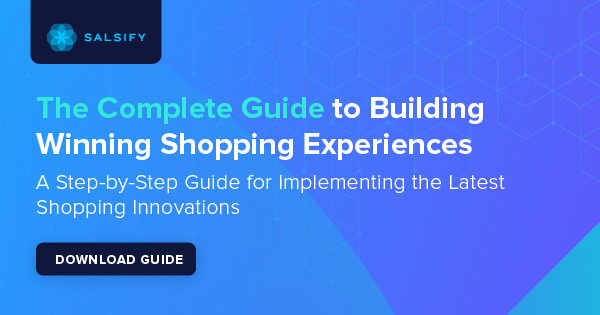

The Complete Guide To Building Winning Shopping Experiences
Download Salsify’s guide for more inspiration on improving shopping experiences across the digital shelf.
DOWNLOAD GUIDEPIM
Manage all product content in one central system of record.
Syndication
Easily syndicate product content to every consumer touch point.
Enhanced Content
Enrich product pages with below-the-fold content and rich media.
Intelligence Suite
Bring AI-powered capabilities directly into your Salsify workflows.
Grocery Accelerator
Leverage the first-ever category-wide PXM accelerator in the grocery industry.
GDSN Data Pool
Synchronize standard supply chain, marketing, and ecommerce attributes globally.
Digital Shelf Analytics
Continuously optimize your organization’s product content syndication.
Catalog Sites
Share secure, on-brand, and always up-to-date digital product catalogs.
Automation and AI
Automate business processes and enhance Salsify workflows with AI.
PXM Platform, Integrations, and APIs
Integrate the PXM platform with the rest of your enterprise systems architecture.
Supplier Onboarding
Accelerate supplier onboarding while ensuring your schema requirements are met.
Product Listing
Sell products faster with Product Listing.
Content Enrichment
Increase online conversions with Content Enrichment.
Automation
Save time and increase operational efficiency with retail automation.
SXM Platform, Integrations, and APIs
Integrate the SXM platform with the rest of your enterprise systems architecture.
Syndication Network
Automate how you exchange product content data to the digital shelf.
Enhanced Content Network
Turn product pages into product experiences with Enhanced Content.
Commerce Platform Integrations
Create winning product experiences everywhere shoppers are, including on owned sites.
GDSN Data Pool
Synchronize standard supply chain, marketing, and ecommerce attributes globally.
Open Catalog
Connect to the digital shelf faster with an open, standardized, and free product catalog.
Resources
Resource Library
Explore our ecommerce resources to get everything you need to win on the digital shelf.
Blog
Read our blog to get actionable insights for navigating changing markets and industry demands.
Webinars
Watch our on-demand ecommerce webinars to gain expert advice and tips from our community of industry leaders.
Customer Blog
Gain the latest tips, industry trends, and actionable ecommerce insights.
Knowledge Base
Investigate our knowledge base to build your Salsify skills and understanding.
API
Examine our comprehensive API and webhook guides to start working with Salsify quickly.

Download the report to get expert insights, consumer research, and top industry trends.

We all engage in a little retail therapy now and then — gifting ourselves the occasional treat is a proven mood booster, and it’s harmless when done in moderation.
For brands and retailers, shopping therapy can contribute to a significant amount of sales. So, it’s to your benefit to create shopping experiences that are pleasant, relaxing, and generally likely to lift shoppers’ moods.
In the past, this meant creating in-store environments that were attractive and easy to navigate.
Today, as more retail moves online and retail therapy follows, brands and retailers need to update their approach.
So, what is retail therapy in a modern retail environment, and how do brands and retailers adapt accordingly? Here’s an in-depth look at how shopping is therapy.
Retail therapy is when a shopper buys themselves an item that they want but don’t need to make themselves feel better. It is, of course, no replacement for actual therapy, but according to TIME, it can have real psychological benefits when enjoyed in moderation.
In the past, retail or shopping therapy typically involved browsing a favorite store or wandering the mall, but today, much of it happens online — conversion rate optimization agency Invesp reports that almost 40% of all money spent on ecommerce comes from impulse purchases, which are typically connected to retail or shopping therapy.
This is most likely due to the convenience of ecommerce. Instead of taking a few hours out of their day to visit a store, shoppers can now browse their favorite brands on their phones during their lunch break. If they see something they like, they can typically check out in just a couple of clicks.
Many retail therapy purchases are impulsive ones because shoppers are drawn in by the quickness and convenience of the experience.
Invesp also says that eight out of 10 impulse shopping happens in brick-and-mortar stores. As convenient as online shopping is, it doesn’t always offer the same type of novel experience that shoppers seeking this therapy want.
Ultimately, preferences between in-person and online shopping differ from person to person, sometimes even from day to day.
Whatever mode your shoppers choose, the important thing is to make sure it’s enjoyable and memorable so their shopping therapy experience leaves them feeling happier.
It’s worthwhile for brands and retailers to understand who’s likely to engage in shopping therapy or make impulse purchases. The short answer? Shopping is therapy for just about everyone.
A Deloitte survey found that 77% of global consumers bought something to treat themselves in the past month. In some countries, including the U.S. and Australia, that number approached 80%.
While everyone treats themselves occasionally, some demographics do so at a higher rate than others. The same survey found that higher-income consumers are more likely to splurge than lower-income consumers, though both do at high rates (81% and 72%, respectively).
Across all income categories, food and drink is the most common indulgence, but higher-income shoppers are likely to splurge on personal care or clothing and accessories as well.
Deloitte’s survey also found that, despite stereotypes around women’s love of shopping, men and women engage in shopping therapy at a fairly equal rate — and men, on average, spend more on splurges than women.
This may have something to do with what they’re purchasing: According to Statista, women are more likely to splurge on clothing and accessories, while men most often treat themselves to electronics, which can have bigger price tags.
Finally, shopping is therapy for younger people more often than older people. Globally, 85% of Generation Z and 81% of millennials will treat themselves while shopping, compared to 74% of Generation X and 70% of boomers.
Exactly how retail therapy trends and demographics inform your strategy will be unique to each brand and retailer, but there are some best practices that almost everyone can leverage to provide satisfying shopping therapy experiences.
These best practices primarily concern providing engaging omnichannel shopping experiences so your consumers are satisfied no matter where they’re shopping.
Omnichannel shopping means making experiences consistent, accessible, and enjoyable on all shopping channels — including online, in-store, mobile devices, and wherever else your consumers may be.
Being proactive about the quality of your omnichannel approach can improve your ability to cater to shopping therapy trends. Here are some additional tips for doing so.
One important factor of omnichannel success is providing consistent, easy-to-navigate experiences across all channels. Inventory information provided in stores, on digital platforms, in apps, and anywhere else you have a presence should line up, and purchases should be equally easy on all channels.
Modern shoppers are accustomed to browsing online while in stores, making digital purchases that can be returned in-store, and other activities that require an omnichannel strategy. Not only that, but omnichannel consistency leads to peace of mind, which is one major thing people engaging in shopping therapy want.
An attractive digital storefront that’s easy to navigate leads to enjoyable shopping experiences, which in turn leads to a more successful retail therapy experience.
Research published in the Asia Pacific Journal of Marketing and Logistics supports this, saying that the aesthetics of an online shopping platform has a direct impact on shopper mood.
If shoppers enjoy browsing your site, they’ll enjoy purchasing from you and want to come back the next time they need a retail pick-me-up.
Part of having an attractive digital shelf is having product content that’s engaging, eye-catching, and informative. This is important both because it makes the digital shopping experience more enjoyable, and because it helps consumers know exactly what they’re getting — making it more likely that their impulse purchase won’t result in a return.
When they turn to retail or shopping therapy, consumers are seeking a quick mood boost via an experience that’s fun, easy, and satisfying.
Of course, you can’t solve all the emotional needs of consumers, nor should you try. What you can do is make sure you’ve created winning shopping experiences so enjoyable that shoppers can’t help but feel a little happier when they visit your site. If you follow this approach, retail therapy can become a win-win for you and the consumer.

Download Salsify’s guide for more inspiration on improving shopping experiences across the digital shelf.
DOWNLOAD GUIDENicole D’Angelo (she/her) is a freelance writer, editor, and content marketer with over eight years of experience creating content for various industries. Previously, she managed content production for business-to-business (B2B) and business-to-consumer (B2C) brands, including Fortune 500 companies.
Standing out on the digital shelf starts with access to the latest industry content. Subscribe to Below the Fold, our monthly content newsletter, and join other commerce leaders.